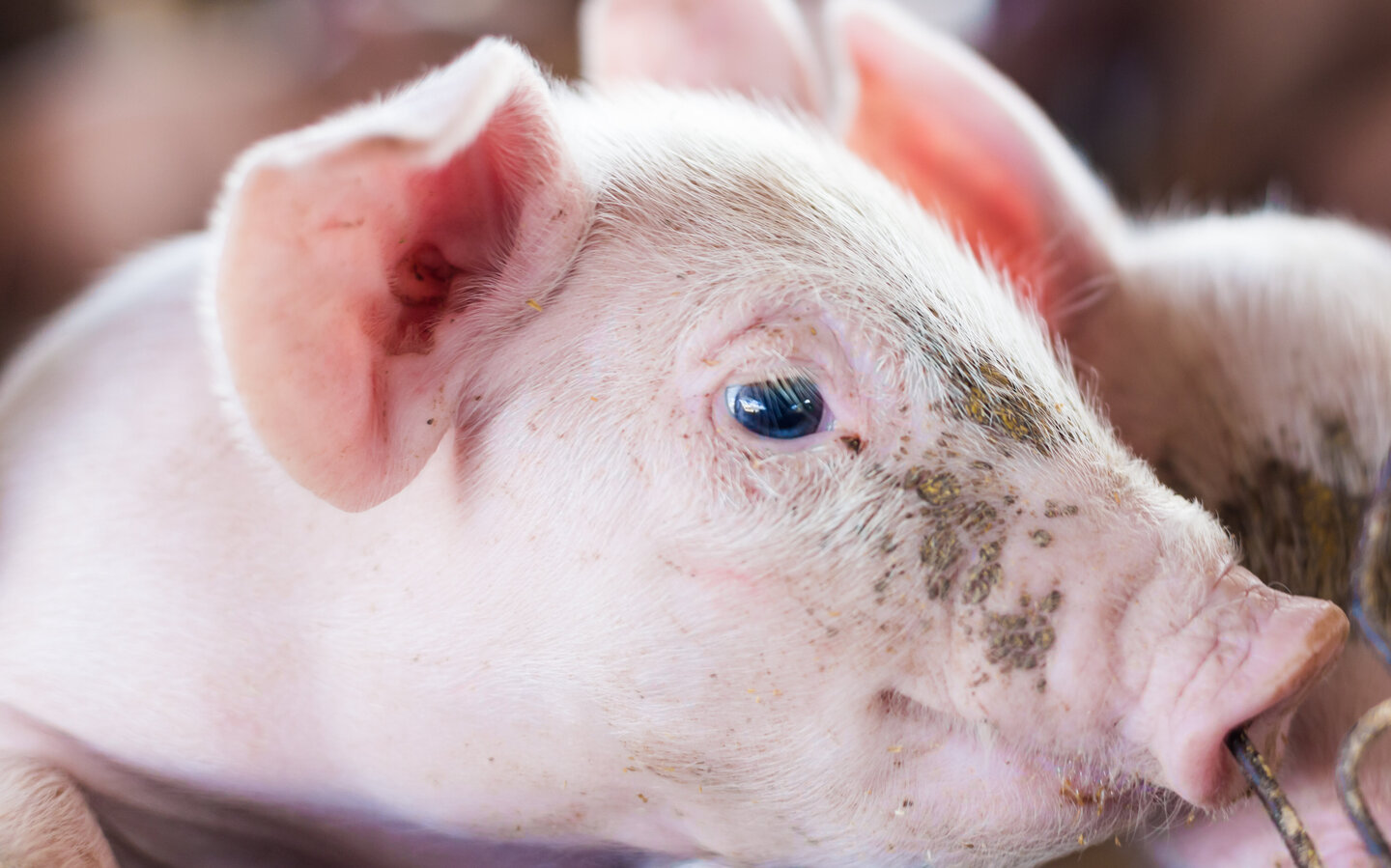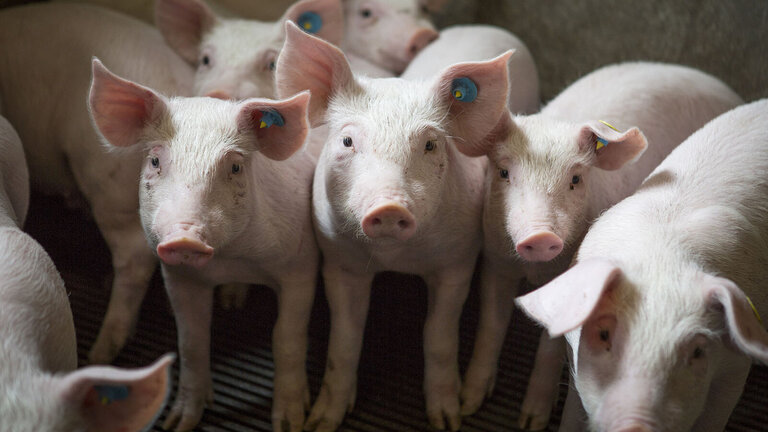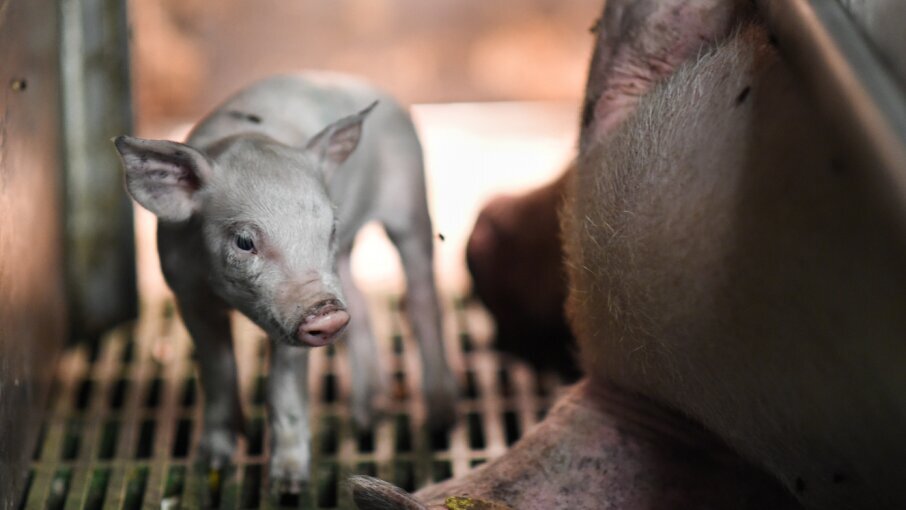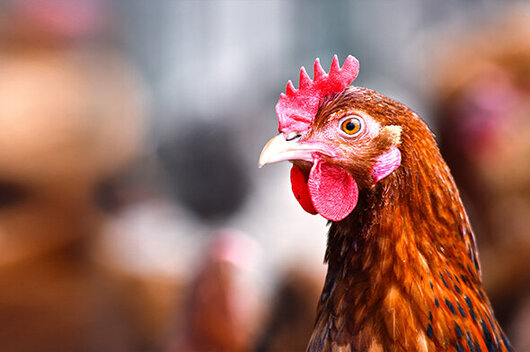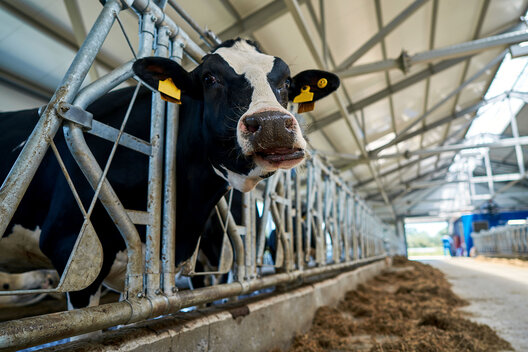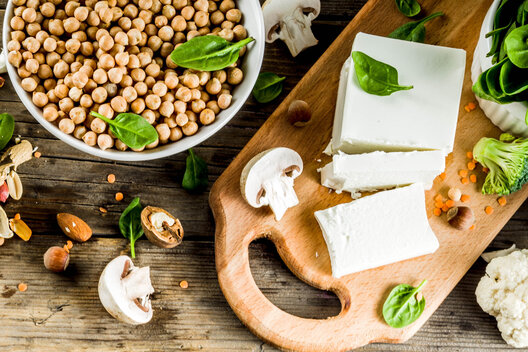Pigs in agricultureHow pigs live today
Pigs can live up to 20 years. In agriculture, however, they are usually slaughtered for their meat at the age of six months. During their short lives, they cannot meet their needs and have to endure unacceptable conditions. Pig farming in Germany, which is contrary to animal welfare standards, must come to an end.
Pigs like to dig in the ground, wallow, spend a lot of time looking for food and are very social creatures that live in groups. However, the pig industry ignores the natural behavior of these intelligent and clean animals. Instead, it is completely geared towards profitability and is divided into different "production sections": piglet production, piglet rearing and fattening. Each area has been optimized for profit - and at the expense of the animals. Most pig farms have specialized in one of these areas. However, the needs of the pigs fall by the wayside.
Slatted floors lead to injuries
Currently, over 90 percent of pigs in this country are kept "conventionally". This husbandry system does not take the animals' needs into account at all. In accordance with their nature, pigs always place their excrement area as far away as possible from their sleeping nest - they do not have this option in conventional husbandry. Here, pigs stand on barren concrete floors with gaps through which excrement and urine fall. The animals often injure their claws and legs on the hard, slippery and unsafe surface without bedding. It also stinks of urine, and the rising ammonia vapors irritate the eyes and respiratory tracts of the sensitive animals. Many of them also suffer from respiratory diseases.
No employment and docked tails
In conventional husbandry, the animals have neither exercise nor opportunities to pursue their favorite pastimes. In a natural environment, pigs spend around 70 percent of their time foraging for food - otherwise they like to wallow and burrow. In industrial farming, there is also no material such as straw that would be suitable for occupation and feed. The animals are trapped in a confined space and get bored, which causes behavioral disorders such as "bar biting" and "mourning" - in the latter case, the animal sits on its hind legs and hangs its head. Cannibalism is also possible. The movable curly tails of conspecifics are a distraction for the pigs from their dreary lives. The animals nibble at each other, causing serious injuries. To prevent this, the animals' curly tails are amputated in the first few days of their lives. The practice is extremely painful and is carried out without anaesthetic as long as the piglets are less than three days old. Even after the procedure, the animals are not given any painkillers.
Sows endure in a cramped stall
Pigs naturally want to give birth to their piglets in self-built nests - but they are denied this in intensive farming. There, it is common practice to keep them in so-called crates for months at a time. These are narrow cages designed to prevent the sows from crushing their piglets. The sows can barely move in them and cannot even turn around. They can only stand up and lie down. The sows sit there impassively or bite at the bars. This practice will remain permitted until 2036, due to a legal transitional period that applies until then.
More and more piglets
Sows have been bred to have more and more piglets. As a result, litter sizes have grown steadily over the last few decades. The higher number of piglets per litter means that the animals are bound to suffer massively. Many of them weigh too little at birth, are too weak to suckle and fall ill. The farmers do not look after these piglets for economic reasons. The animals either die in agony or are killed. It is not uncommon for the animals to be stunned and killed incorrectly, resulting in prolonged suffering and pain.
In addition, the farms routinely grind down the canines of the surviving piglets in their first few days of life so that they do not injure the sow or each other when they fight for the teats. This is because the number of piglets per litter is now often greater than the number of teats a sow has. According to the Animal Welfare Act, the grinding of canine teeth is permitted without anaesthetic. This exposes a highly sensitive nerve area, causing unimaginable pain to the piglets.1
More power through hormones
In conventional sow husbandry, most breeding sows are given hormone treatments to increase their performance. The aim is for them to give birth to more piglets per year than they would naturally produce. The hormone PMSG is particularly criticized here, also because of its cruel extraction from the blood of pregnant mares. PMSG is used to make work easier so that the sows on the farm have their piglets at the same time. However, the hormone can also increase the number of piglets per litter, which leads to excess piglets and can result in higher mortality.
At the age of 3-4 years, a breeding sow has "had its day". As soon as her performance drops, she is worthless for the farm and is slaughtered. The use of hormones such as PMSG is prohibited in organic pig farming.
Early separation from the mother
The piglets are separated from their mothers extremely early - often after just three weeks - and are kept in the piglet rearing house until they are ten to 15 weeks old. There, the animals are often kept in groups in so-called flat decks. These are flat, unstructured pens with a completely perforated floor and no bedding or enrichment material. Four to five piglets are housed per square meter. Flat decks can be stacked up to three levels high, which is referred to as a piglet battery.
Castration in the first week of life
Male piglets are surgically castrated in the first seven days after birth. In this way, farms want to avoid the so-called boar taint. This particular smell can be detected after slaughter when the meat is heated. The piglet's legs are spread apart and fixed in place to remove the testicles. Until the end of 2020, young animals even had to undergo castration without any anaesthetic. However, even under anaesthetic, the procedure is very stressful for the animal and risky: possible post-operative bleeding and infections put a strain on animal health. The piglets suffer great pain even after the procedure. From an animal welfare point of view, it would be best not to castrate the piglets at all - i.e. to fatten them as boars or, if necessary, to vaccinate them against boar taint instead.2
Fattening pigs at six months in the slaughterhouse
Thousands of fattening pigs live alone in an industrial facility, divided into narrow pens, with no exercise area and no access to daylight. The pens are so small that the animals can barely move around and cannot avoid each other. Many animals are left to vegetate. A pig weighing 80 kilograms has to live on three quarters of a square meter. The larger and heavier the animals become during fattening, the less space they have. The feed for the fattening pigs contains a lot of energy so that they grow quickly and put on a lot of weight. After just six months, the animals weigh around 120 kilograms. They are then slaughtered at this young age. The drastic growth overloads their bodies and leads to diseases of the bones and joints. The cardiovascular system is also overstretched. For the pigs, this means pain and stress, which in turn leads to stomach ulcers.
What is animal-friendly pig farming?
Pigs want to wallow in the mud outside and burrow in natural soil. Outdoors, they can also find a place to do their business far enough away from their lying area. All of this is part of their natural behavior. They can only perform these behaviors outdoors, which is the most animal-friendly way for pigs. After a short period of acclimatization, they can live outside all year round - just like their wild counterparts.
What you can do
Animals die for the schnitzel on your plate: In Germany, around 53 million pigs are killed for their meat every year. To stop supporting this, you can set an example when you shop. As a consumer, you send a signal to business and politics with every purchase. If your shopping cart contains mainly plant-based ingredients, you are showing that you no longer accept the situation of farmed animals. In addition to fruit, vegetables and pulses, every supermarket now offers numerous other vegan foods: Meat substitutes such as vegan "schnitzel", "sausages" or plant-based "minced meat" can add familiar flavor to your diet. If you still want to buy pork, you should only choose products that are labeled with labels such as the animal welfare label "Für Mehr Tierschutz" (For More Animal Welfare) from the German Animal Welfare Federation.
- Exercise area for all pigs
- littered lying areas in the barn
- significantly more space in the barn than required by law
- different areas in the pens so that the pigs can rest, eat and defecate in different places
- the complete abolition of slatted floors
- suitable organic enrichment material, for example straw or hay
- No confinement of sows in crates
- Moving away from breeding for ever larger litters
- Farrowing pens with sufficient space and free movement for the animals
- Group housing for sows directly after weaning the piglets
- Prohibit amputations (castration, tail docking) and teeth grinding
- Breeding robust pigs that grow slowly
- Breeding sows that can look after their piglets and do not have more young than they have teats
- Stricter controls on animal transportation
- Revision of transport regulations, in particular on transport times, space available, temperatures
- Ban on animal transports lasting longer than eight hours
- Ban on the export of live animals to countries outside the EU
- Transporting frozen meat or genetic material instead of live animals
- Stricter regulations on slaughtering
- Better monitoring of slaughterhouses
This has an impact on farmers' wages and on pig husbandry.
Sources and further information
1 You can find more information about grinding the canines of piglets on the vetline veterinary portal.
2 Further information on the surgical castration of piglets and alternatives can be found in our position paper. (available in German only)

